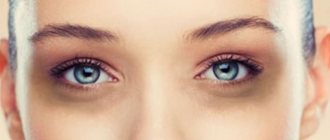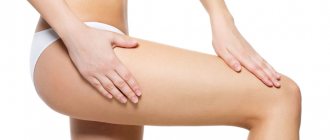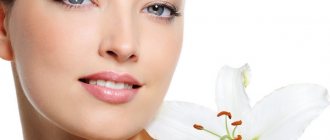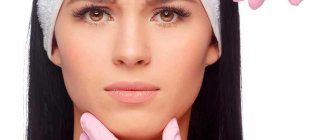Botox injections into the neck are a rejuvenating cosmetic technique that successfully fights age-related skin changes and prevents the appearance of new ones. The skin on the neck and décolleté is much thinner than on other parts of the body, so it begins to age earlier, revealing a person’s true age. The Botox procedure in the neck is safe, painless and effective. The first results can be assessed within 3–4 days, and the maximum effect develops within 15–20 days. The skin at the injection sites is noticeably smoothed, rejuvenated, fresher and more attractive. Cosmetologists of the International Clinic of Hemostasis use only certified drugs, selecting the dosage and administration regimen taking into account the individual characteristics of the patient’s body. Such a responsible approach eliminates the risk of developing negative consequences and guarantees maximum effect.
Operating principle
The skin at the injection sites is smoothed, rejuvenated, and appears healthy and attractive. Cosmetologists use certified drugs and select dosages taking into account the body of each patient. The approach avoids side effects.
Botox is a drug made from botulinum toxin type A. The injection blocks existing neuromuscular impulses and immobilizes muscles. The main goal is the rapid smoothing out of wrinkles formed as a result of increased activity. In case of prolonged paralysis, the creases disappear. By the time the effect of the drug ends, the active substances are eliminated naturally, the muscles are fixed in a static position, preventing the appearance of new defects.
Advantages and disadvantages
Advantages of a drug based on botulinum toxin type A:
- safety. The presence of a harmful toxin in minimal doses, the absence of negative effects on the patient’s body. Intoxication is excluded;
- quick effect. The first results are noticeable on the 3rd day after the injection. Effect within 10 months;
- botulinum toxin is eliminated from the body naturally. A second injection is needed 3-4 months after the initial procedure;
- no side effects. Injections are given by experienced cosmetologists with higher medical education and completion of specialized courses. The risks of applying herbs are minimal.
Negative sides:
- it is necessary to duplicate the procedure after some time. Goals: consolidation of results, support of rejuvenation;
- risks of developing pathologies with incorrectly chosen dosage.
The procedure is carried out by international specialists. Risks of contacting illiterate cosmetologists.
Botox in platysma
The correct choice of botulinum toxin drug for work in a specific area is a very important question. What does a doctor focus on when it comes to correcting aesthetic problems in the neck area?
The neck area is a very complex area of the body in terms of cosmetics. Thin skin and a small subcutaneous fat layer all contribute to its rapid dehydration. A small network of small vessels and slow blood microcirculation, low activity of the muscles of the anterior surface of the neck, all this forms a decrease in muscle tone and tissue atrophy, early skin ptosis appears and longitudinal and transverse wrinkles, cords and ring-shaped folds along the neck are formed, all these visible problems over time are only increasing. To carry out therapy in the neck area, a step-by-step correction is necessary. These can be injection methods (biorevitalization, contour plastic surgery, etc.) or hardware ones. But it is important to remember that botulinum therapy is carried out, as a rule, at the first stage of correction, which will undoubtedly give a good result.
Pharmacological aspects
Botulinum toxin A belongs to the group of muscle relaxants. The active substance is Clostridium botulimim toxin type A, which blocks the release of acetylcholine at the neuromuscular junction, which leads to the relief of muscle spasm in the area of its administration. In first-generation drugs, the botulinum toxin molecule consists of a neurotoxin (active substance) and a protein complex, including non-toxin, non-hemagglutinin proteins and hemagglutinins. Under physiological conditions, such a complex disintegrates to release pure neurotoxin.
When administered locally in therapeutic doses, the active substance does not penetrate the blood-brain barrier (BBB) and does not cause significant systemic effects. Antibodies to botulinum toxin type A are formed in 1–5% of patients after repeated injections. This is facilitated by the administration of the drug in high doses (for example, more than 250 units of Botox) and injections in small doses at short intervals.
Purified botulinum toxin is of increased interest, since its use reduces the risk of the formation of neutralizing antibodies in tissues. The fact is that the indications for the use of BTA in cosmetology have long been not limited to wrinkles between the eyebrows and the upper third of the face, where relatively small dosages are used with an interval of 5–6 months (in these cases, the risk of resistance is minimal, since the introduction of complexing proteins is insignificant). Today, botulinum toxin preparations are used in the lower third, and in the periorbital region, and in the neck area, and for the treatment of rosacea, seborrhea, etc., which requires more frequent use of toxins (that is, booster injections), and in significant dosages. For this purpose, it is preferable to opt for purified preparations that do not contain complexing proteins.
Characteristics of botulinum toxin preparations
Diffusion of drugs
From a physical point of view, the distribution, or diffusion, of botulinum toxin depends on the drug itself and the state of the tissue into which it is injected. In the case of tissue sparseness, which occurs during involutional changes, diffusion increases, so in elderly patients there is a high risk of side effects in the form of unwanted entry of botulinum toxin into neighboring muscles.
As for the drug, two factors should be taken into account: its viscosity and the size of the molecule.
It makes sense to compare the size of molecules only for identical drugs, that is, those containing a neurotoxin and complexing proteins (for example, Botox and Dysport). “Xeomin” is completely purified and begins to work in tissues immediately, so its diffusion takes place differently. As for the viscosity of the drugs, according to the data presented, having the maximum amount of albumin in the form of an excipient (a component that performs a supporting function and regulates the process of penetration of active substances into the skin), Xeomin exhibits minimal diffusion.
Since all drugs are lyophilisates, to carry out the procedure it is necessary to restore botulinum toxin with 0.9% sodium chloride solution. The volume of sterile saline solution is added according to the manufacturer's instructions and depending on the indications. As a rule, studying experience, taking into account the instructions for the drugs, the recommendations of various consensuses (and they have not yet come to a common denominator), the following standard dilutions are used.
Dilution of drugs in standard regimens.
Features of neck area correction
The texture of the skin of the neck cannot be restored without botulinum therapy, since hypertonicity of the subcutaneous muscle of the neck (m. platisma) not only leads to the early manifestation of involutional changes, but also causes ptosis of the soft tissues of the lower third of the face and the formation of “jowls”.
M. platisma is a fairly thin muscular plate that is located under the skin of the neck, merging tightly with it. Its muscle bundles begin in the chest area at the level of the 2nd rib and are directed upward and medially. At the edge of the lower jaw, the medial bundles of one side of the muscle intertwine with the bundles of its opposite side and are attached to the edge of the lower jaw, and either their excessive intersection or its absence can be observed (Fig. 1). According to the literature, the usual variant, or type I, occurs in 75% of people, type II with excessive intersection - in 15%, and type III with no intersection - in 10% of the population. The best results of botulinum therapy are observed in patients with type I intersection. Laterally the bundles of m. platisma pass to the face, where they are woven into the fascia of the parotid gland, reaching the corner of the mouth.
Figure 1. Anatomical variants of the mandibular symphysis platysma.
The subcutaneous muscle of the neck protects the saphenous veins from compression. M. platisma works as a depressant and supports the soft tissues of the neck. Although strictly speaking it cannot be considered a muscle of the head, it plays an important role in the formation of facial expression. When contracted, it pulls the skin of the neck and lower jaw downward. Platysma also helps the movement of the upper lip. In addition, it forms a powerful symplast with DAO (m. depressor anguli oris - muscle that depresses the angle of the oris), enhancing the effect of this depressor.
When carrying out botulinum therapy in the neck area, due to the strong symplast of the platysma with nearby muscles, it is preferable to work with drugs with low diffusion. In addition, the choice of drug is determined by the presence of complexing proteins in it. Since the total dosage of botulinum toxin administered is relatively large (for example, Xeomina - 50-60 units), the load with foreign protein should be minimal. The instructions for use of the drug must indicate these indications.
Hypertonicity m. platisma is determined when pronouncing the sound “s”. Injections are carried out superficially subcutaneously, the distance between injections is 2–3 cm.
In addition, with pronounced hypertonicity of the muscles in the lower jaw area, so-called “jowls” are formed and the procedure is performed by placing two to four subcutaneous injections. It should be noted that, as a rule, not all strands of the subcutaneous muscle of the neck are in a state of hypertonicity, so only those for which this condition is determined should be corrected.
Botulinum toxin injections in the neck area are often performed as part of complex correction of facial contours. For example, for the “Oval of Nefertiti” procedure (photo 1), it is desirable to remove the hypertonicity of the DAO and mentalis muscle (m. mentalis), since their symplast in the lower jaw area is strongly pronounced and constitutes a whole complex of depressor muscles that are in hypertonicity: m. depressor anguli oris, m. mentalis and m. platisma.
Photo 1. Diagram of the location of injection points into the subcutaneous muscle of the neck when correcting the oval of the face (the “Nefertiti Oval” procedure).
Patient, 58 years old: a – before, b – after correction of the platysma bands of the BTA.
Patient, 44 years old: a – before, b – after correction of the platysma bands of the BTA.
Conclusion
It is necessary to understand that there are no bad or good drugs. There is a structure and physical and chemical components of the product that determine its priority use in various clinical cases. So, there are very important circumstances when correcting the neck with botulinum toxin, which the doctor should take into account:
1. Use of relatively large doses, which requires minimizing the load of foreign protein.
2. Repeat procedures at short intervals.
Boosting (small doses of botulinum toxin administered at short intervals) can lead to the development of insensitivity to botulinum toxin. If a doctor uses botulinum toxin in his work only to correct wrinkles between the eyebrows and the upper third of the face once every 5-6 months, then the issue of protein load is irrelevant, and the choice of drug is as wide as possible. But if this is correction of the lower third of the face and neck, then second generation botulinum toxin becomes the drug of choice.
3. Features of facial muscles. The facial muscles are very small in size and volume and often form a symplast with antagonist muscles, so the choice of the drug is based on the viscosity of the solution and the ease of working with it.
Zhanna Yusova, Ph.D., leading researcher of the NPO of physiotherapy, cosmetology and rehabilitation of the Federal State Budgetary Institution NKTsO FMBA of Russia, Associate Professor of the Department of Aesthetic Medicine of the Faculty of Pedagogical Training of the People's Friendship University of Russia, dermatovenerologist, cosmetologist, physiotherapist, member of the European Academy of Dermatovenereologists, Moscow
Indications and contraindications
The procedure is indicated for patients aged 30+. Reason: formation of primary signs of age-related changes. An injection using the active component of botulinum toxin is indicated for:
- pronounced flabbiness;
- rapid formation of looseness;
- partial or complete loss of elasticity;
- rapid decrease in tone;
- the formation of deep circular folds;
- vertical and horizontal wrinkles;
- formation of a double chin;
- rapid development of gravitational ptosis;
- blurry oval face.
Botulinum therapy has contraindications. The decision to administer an injection is accompanied by a consultation with a treating specialist and comprehensive laboratory tests. Goals: to eliminate side effects and negative effects on the patient’s body.
Contraindications:
- benign or malignant tumor, other oncological diseases;
- diseases of the circulatory system;
- pronounced inflammatory processes;
- damage to the injection sites of active substances;
- development of myasthenia gravis;
- inflammatory processes of chronic diseases;
- hormonal imbalances;
- problems with the endocrine system;
- mental disorder;
- problems with heart muscle contraction;
- acute liver and kidney failure – stage of the inflammatory process;
- intolerance of the body to individual components of the drug;
- increased tendency to form keloid scars.
Additionally: the use of local and general antibiotics, antispasmodics, steroid drugs.
Gymnastics
At the first sign of a problem, exercise can be effective. They are aimed at increasing muscle tone. Here are some examples of neck muscle training:
- Starting position – standing or sitting. Slowly rotate your head, and then bow it and completely relax your muscles.
- Lower the corners of your lips so much that you feel the tension in your neck muscles. Stay in this position for about 15 seconds. Then relax and repeat.
- Slowly tilt your head forward and back eight times in each direction. You can't move your shoulders. Then relax and repeat.
- Slowly lower your head alternately to your right and left shoulder.
- Fix the shoulder girdle and head. Separately, make a circle with your neck: move it forward, then to the right, return to the starting position, move it to the left and then forward. Repeat four times with rest after each.
- Slowly turn your head to the right so that your chin goes behind your shoulder, stretching the neck muscle. Repeat to the left.
- Smoothly turn your head alternately in both directions without returning to the starting position.
More effective methods for removing and correcting Venus rings are offered by modern medicine and cosmetology.
How is the procedure done?
Stages of implementation:
- Initial removal of existing makeup.
- Effective skin cleansing using special products.
- Using anesthesia – relieves severe pain during the injection.
- Marking sites for future injections. The distance between the inputs is no more than 2 centimeters.
- Systematic introduction of the active component into the subcutaneous tissue.
- Applying a cooling, soothing cosmetic product.
The duration of the procedure is 15 minutes. The anesthesia works instantly. There is no side effect. Minimum rehabilitation period.
Technique 1. Rejuvenation squared
Enhancing the effect of mesobotx with the help of biorevitalizants. These are hyaluronic acid preparations that moisturize the skin and maintain its water balance for a long time.
Consecutive administration of drugs within one procedure gives an amazing effect. Mesobotox smoothes the skin, improves its structure, and hyaluronic acid gives firmness, elasticity, and freshness.
Acting together, these components work like two catalysts, enhancing and prolonging each other's effects.
Rehabilitation period
Rehabilitation period after administration of the active substance botulinum toxin:
- prohibition for patients to take a horizontal position in the first 4 hours after administration of the drug - the injection site does not matter. Ensures uniform distribution of the product under the skin;
- more limited use of decorative cosmetics – 6 days;
- Limit intake of fatty, fried, salty, spicy foods for 14 days. Consolidation of the Botox effect;
- Consumption of strong alcoholic drinks, carbonated water (sweet, mineral) is prohibited – 14 days
- limited consumption of strong tea, coffee – 7 days;
- minimum physical activity – 14 days;
- ban on visiting gyms – 10-14 days;
- exclude visiting the bathhouse, solarium, sauna;
- minimum stay outdoors under direct sunlight – 3 days;
- exclude massage and peeling until toxins are completely removed from the patient’s body.
Exceptions: testimony of cosmetologists based on examination results.
Botox injections into the neck are a rejuvenation technique used by cosmetologists to eliminate age-related changes in the skin, remove wrinkles and folds. The skin in the décolleté area is thin compared to other areas of the body. Therefore, the previous age clearly indicates the real age of a person.
ELOS – course restoration of skin structure
ELOS is a hardware procedure without damaging the epidermis. This is a synergy (combination) of two energies - light and RF energy, due to which collagen production is stimulated, the skin becomes smoother and more elastic. In addition to rejuvenation, ELOS therapy eliminates age spots and vascular spots and returns the skin to an even and healthy color. ELOS therapy does not require rehabilitation, does not exclude you from social life and does not depend on the season. However, to achieve results, it is necessary to undergo not just one, but a course of procedures (3-6 procedures once a month).









